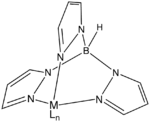Spectator ligand
In coordination chemistry, a spectator ligand is a ligand that does not participate in chemical reactions of the complex. Instead, spectator ligands (vs "actor ligands") occupy coordination sites.[1] Spectator ligands tend to be of polydentate, such that the M-spectator ensemble is inert kinetically. Although they do not participate in reactions of the metal, spectator ligands influence the reactivity of the metal center to which they are bound.
Several different classes of ligand that can be considered spectator ligands. A few examples oinclude trispyrazolylborates (Tp), cyclopentadienyl ligands (Cp), and many chelating diphosphines such as 1,2-bis(diphenylphosphino)ethane ligands (dppe). Varying the substituents on the spectator ligands greatly influences the solubility, stability, electronic and steric properties of the metal complex. In the area of platinum-based antineoplastic agents, spectator (and nonspectator) ligands greatly affect efficacy.[2]

-3D-balls.png)
References
- ↑ "Spectator Ligand (Ion)". Encyclopedia of Inorganic and Bioinorganic Chemistry. 2011. doi:10.1002/9781119951438.eibd0729.}
- ↑ Timothy C. Johnstone, Kogularamanan Suntharalingam, Stephen J. Lippard "The Next Generation of Platinum Drugs: Targeted Pt(II) Agents, Nanoparticle Delivery, and Pt(IV) Prodrugs" Chem. Rev., 2016, volume 116, pp 3436–3486. doi:10.1021/acs.chemrev.5b00597